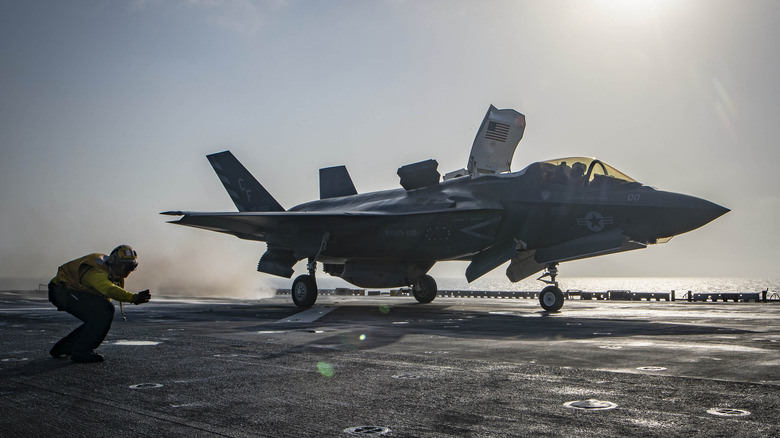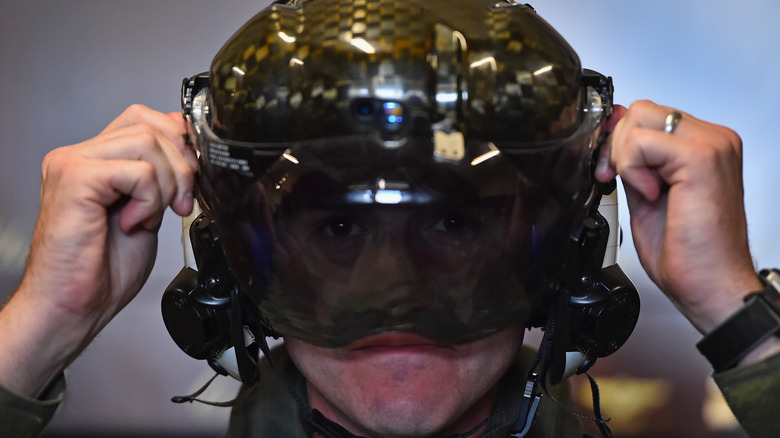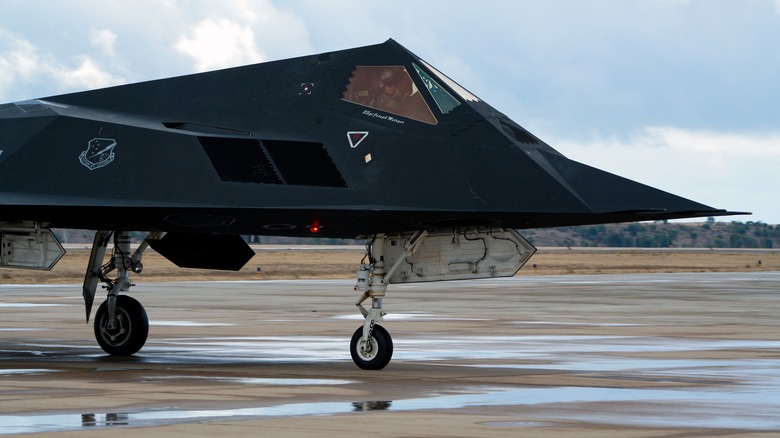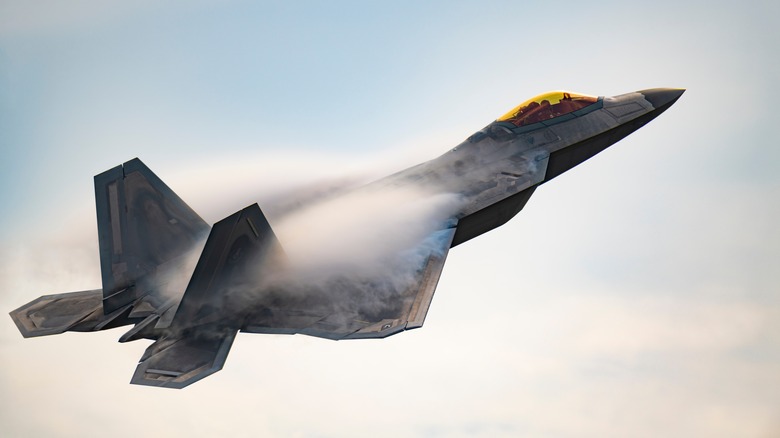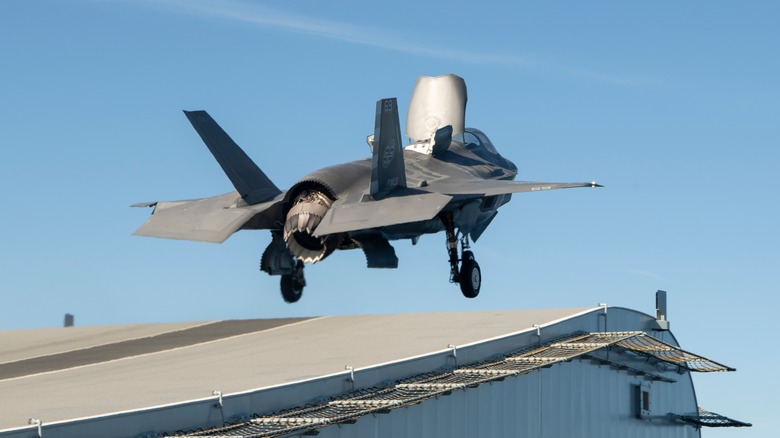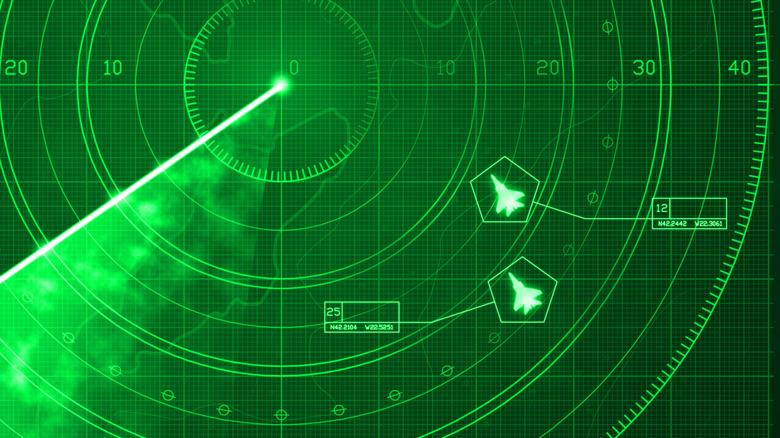Top Gun Tech: 5 Incredible Features Inside Modern Fighter Jets
Nearly 40 years have passed since the premiere of "Top Gun," which introduced general audiences to the combat capabilities of the United States Navy. The 1986 film heavily featured the F-14 Tomcat, the most advanced fourth-generation fighter jet in the Navy's arsenal at the time. When it comes to speed, the Tomcat can still outpace modern fighter jets like the F-35 and F-22. The world has moved from fourth-generation fighter jets to fifth, with a sixth generation currently in the works.
Fifth-generation fighters provide a wide array of more advanced capabilities than their predecessors. From better avionics to upgraded weapons systems to improved situational awareness, modern-day fighter jets provide their pilots with an unrivaled advantage in the air. The United States' fifth-generation fighters include the F-22 Raptor (which is no longer in production) and the F-35 Lightning II. Some other fifth-generation jets are the Russian Su-57 Felon and the Chinese Chengdu J-20.
Helmet-mounted display systems are something out of science fiction
Helmets are nothing new to fighter pilots. Anyone who has seen "Top Gun" knows exactly what helmet American fighter pilots wear since the design hasn't changed much since the '80s. Until now, that is. Modern-day fighter pilots are using and testing a couple of next-generation helmets with advanced technology embedded in them, making pilots more efficient at their jobs. F-22A Raptor pilots from the 301st Fighter Squadron at Eglin Air Force Base in Florida are testing an updated version of the old helmet that increases mobility, visibility, and comfort. Engineers crafted this helmet from lightweight carbon fiber to help during high-speed maneuvers. The helmet has night vision goggles, a jawbone-activated light, and a cueing system.
While that's impressive, F-35 pilots use one of the most advanced helmets in the U.S. military. Every aircraft in existence comes equipped with a heads-up display (HUD) containing the craft's radar, airspeed indicator, and altimeter to keep them aware of their surroundings. The F-35 has a HUD, but it also sends all mission-critical information directly to the helmet's visor, greatly increasing the pilot's responsiveness. Furthermore, F-35 pilots can receive a 360-degree view of their jet's external conditions on their visors, eliminating the need to turn their heads or tilt the plane.
Low observable stealth makes it hard to track
Thanks to the early stealth technology from the F-117 Nighthawk, America's first stealth fighter, America is capable of designing its modern fighter jets with improved stealth capabilities. In fact, stealth is a primary focus of most modern fighter jets, as evidenced by the F-22 Raptor and F-35 Lightning II. These advancements don't make fighter jets completely invisible to radar, but they do help with evading enemy detection, which is useful when pilots need to get in and out of contested airspace quickly.
Lockheed Martin, the manufacturer of several top-of-the-line aircraft, designed the F-35 and F-22 with reduced engine signatures and unique edges to make their radar cross sections as small as a marble. This not only makes it difficult for enemies to detect the aircraft, but it also makes it challenging for air-to-air and surface-to-air weapons to acquire a missile lock on the jets.
Modern fighter jets have a need for speed
Next on the list of priorities for aircraft manufacturers is giving fighter jets the ability to fly at supersonic speeds for an extended period of time without engaging the afterburners. This feature is known as supercruise, and it offers a fuel-efficient method for flying at high speeds. While most fighter jets from previous generations expend fuel at an increased rate to maintain supersonic speeds, the F-22 Raptor cruises at speeds greater than Mach 1.5 with the same fuel consumption.
Any aircraft capable of supercruising is able to effectively expand its operational range. Jets without this ability have to use an external fuel reserve, which adds weight and reduces maximum speeds. Additionally, the sophisticated, sleek aerodynamic design and high thrust-to-weight ratio of modern jets allow for more maneuverability. The F-22 is one of the most agile aircraft thanks to vectoring nozzles in the jet's engines that assist with turning.
The F-35 can fly vertically when necessary
One of the most unique features of the F-35 Lightning II that makes it a suitable multirole aircraft is its ability to vertically take off and land (VTOL). The F-35B is not the first fighter jet to achieve vertical flight. That honor goes to the AV-8 Harrier. However, the F-35B is the first fighter jet capable of supersonic speeds that can also land vertically. The F-35B achieves vertical flight thanks to a swiveling jet pipe that rotates 95 degrees, redirecting thrust downward. Vents under the cockpit and wings open to reveal lift fans producing 40,000 pounds of thrust.
There are a number of operational uses for vertical landing, such as an F-35B returning to an aircraft carrier, carrying an excess of weight that makes a traditional landing impossible. That would also assist with taking off since the runway of an aircraft carrier is significantly shorter than a traditional one. Unlike the British Harrier, test pilots praised the controls on the F-35B, saying, "You had to be an octopus to fly a Harrier."
Complete situational awareness
Situations during combat can change at the drop of a hat without warning. Coordinating attacks and defenses is truly a team effort from those in the air, on the ground, and at sea, but communicating with one another can prove challenging when handling outdated data. The F-35 Lightning II specifically provides all involved personnel with complete situational awareness. Since the F-35 fulfills multiple tactical roles, loading them with advanced sensors is necessary. Those advanced sensors gather and distribute real-time intelligence to other aircraft, ground forces, and sea-based crafts, allowing for more strategic and accurate operations.
While not as advanced as the F-35, all fifth-generation fighter jets come equipped with sensors that improve a pilot's situational awareness, making them surgically precise tools during combat. The F-22, for example, can lock on to a target over 100 miles away and remove it from the equation without ever being detected. The sophistication of fifth-generation fighters is frightening, making the idea of a forthcoming sixth-generation downright intimidating.
